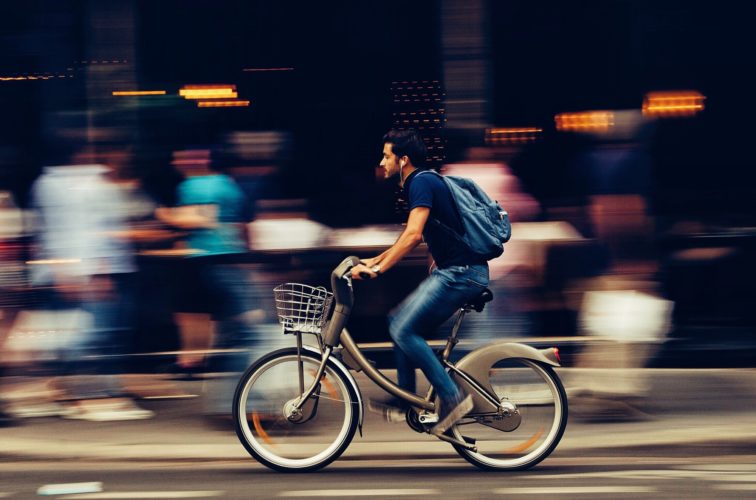Eyes in the back of your head – could mirrors save a cyclist injury?


The number of cyclists involved in accidents on roads across the UK is on the rise, so Minster Law Serious Injury team member David McLaughlin explores the impact bicycle rear view mirrors could have on making the road a safer place.
Humans have a horizontal visual field of around 210 degrees, meaning we are unable to see anything behind our shoulders without turning our head. From an evolutionary perspective, this is seen as an advantage, giving us clear and focused vision directly in front of us to hunt and catch prey. In today’s world however, the concept of hunting is little more than a trip to the local supermarket.
But what about on the roads? Would a greater field of vision enable us to identify the dangers of vehicles approaching from behind?
The concept of having eyes in the back of your head has been around since Roman times. Scientifically however, it would be somewhat impractical, as the brain would have to differentiate between what the eyes were seeing in front and behind and interpret accordingly.
Mirrors have been used in motor vehicles since the 1920’s. In fact, as early as 1909, Dorothy Levitt advised in her book, The Woman and the Car, to carry a compact mirror and “hold it aloft from time to time to see behind while driving in traffic”. She also advised carrying a small revolver, so just be careful as to what advice you choose to follow.
It has also been a legal requirement since 1986 for all motor vehicles (except some commercial and agricultural vehicles) to be fitted with at least two rear-view mirrors. But what about non-motor vehicles, i.e. cyclists? They are road users but do not fall under the legal criteria for compulsory mirrors. Would mirrors on a bicycle share the same benefits as a motor vehicle?
In 2019 a report by the British Cycling State found that 87% (9 in 10) cyclists are “close passed” by vehicles at least once a week. The most dangerous of which are high-sided buses and lorries which, in addition to their limited visibility, have larger, extruding wing mirrors. These mirrors present a greater hazard to cyclists as they are at head height.
In 2010 the former Olympian, James Cracknell OBE, was hit by the wing mirror of a truck travelling at 70mph whilst filming a TV show in America. Fortunately, he was wearing a helmet, which likely saved his life but was not enough to prevent serious injury. He suffered a devastating brain injury – a contrecoup injury to the frontal lobes – the part of the brain that controls things like mood and motivation, leaving him with difficult personality changes and prone to epileptic fits.
If James had been able to see the truck approaching from behind, could he have taken action to protect himself?
Well, this is likely to be due to preference and practicality. There are several mirror accessories available to cyclists which generally fall into one of three categories: handlebar mirrors, helmet mirrors and glasses mirrors.
For someone using a hybrid or mountain bike, a handlebar mounted mirror is a relatively cheap and easy solution. But what about someone using a road bike, where handlebar space is at a premium? A helmet-mounted mirror can be a bit unwieldy and can easily get bashed when the helmet is taken off.
Callum Skinner, a former Team GB track cyclist who won silver at the 2016 Olympics, and physicist Alex Macdonald may have now come up with a solution for those who do not wish to mount anything to their bike or helmet. Their HindSight glasses feature two-part angled lenses with semi-transparent mirror allowing cyclists to see forwards and backwards by shifting focus rather than having to turn their heads.
The diversity of products on the market offers every cyclist an option which suits their needs and budget best. Given the motor industry felt it so prudent to encourage the use of mirrors that they made it compulsory, should the same be said for bicycles?
At Minster Law, we aim to protect the interests of vulnerable road users such as bikers as we recognise that getting access to justice can sometimes be challenging. We are an active member of the Vulnerable Road Users Group (VRUG), a working party that was created to represent the needs of pedestrians, motorcyclists and cyclists. This group lobbies to ministers to ensure that access to justice is available to all.
Having an accident on your bike often means that there is a chance of a more severe injury, that’s why Minster Law will act promptly to help secure the treatment you need to assist you in your recovery.
Our specialist bike team has experience in dealing with bike related injuries such as fractures, head injuries, spinal injuries and amputations and we’ll do everything we can to assist you following your accident. Since 2015, our specialist bike team have secured over £125 million in damages for our clients.